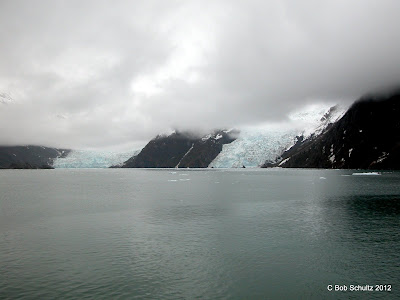Distance and time: about 127 miles/2 hours 40 minutes
 |
| Western Columbine, Kenai Fjords National Park |
South of Anchorage, the Seward Highway, a designated
All-American Road, leads to Seward, Alaska.
 |
| Seward, Alaska small boat harbor |
St. Peter's Episcopal Church
The historic church, the first Protestant church established on the Kenai Peninsula, is at 239 2nd Avenue on the corner of Adams Street in Seward, Alaska.
The year 1904 marked the first services in Seward held in by an Episcopal priest from Valdez. Construction on the building itself took place between 1905 and 1906. Consecration was conducted by the first bishop of the Episcopal Diocese of Alaska, Rt. Rev. Peter Trimble Rowe, on April 1, 1906.
In 1924, the Dutch artist Jan Van Emple came to Seward for an extended visit, and during the following year he undertook a sacred work of art, “The Resurrection,” inside the church behind the altar. Known as a reredos, the mural is a uniquely Alaskan depiction of the Resurrection and Ascension of Christ.
 |
| St. Peter's Episcopal Church, Seward, Alaska |
Instead of the more expected and traditional appearing apostles, the painting depicts people of Alaska including, as the Seward Historic Preservation Commission describes, "Eskimos, a trapper, a fisherman and a pioneer woman make up the foreground. The little Indian mother is unable to lift her head to up to heaven with the rest because her baby weighs so heavily upon her back."
 |
| One view of Resurrection Bay, Seward, Alaska |
 |
| Another view of Resurrection Bay |
 |
| Cruise ships regularly dock at Seward, Alaska |
Alaska Sealife
Center
Question: How much cold, fresh sea water does it take to
keep Alaska’s salt water aquarium fresh and friendly?
Answer: about 4,500
gallons per minute. Visitors to the Alaska Sealife Center are treated to Stellar sea lions, seals, puffins
and other sea birds and representatives of other arctic flora and fauna. It is Alaska’s only permanent marine mammal
rehabilitation center, and is also a marine research and education facility.
 |
| A puffin paddles for onlookers at the Alaska Sealife Aquarium |
Exit Glacier
Exit Glacier, in Kenai Fjords National Park, is one of Alaska’s most accessible glaciers. It is an easy half-mile walk from the visitor’s center.
 |
| Exit Glacier near Seward, Alaska |









